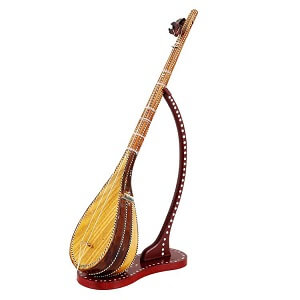Dutar
 The dutar is a two string pear-shaped long-necked lute from western China, played by the Uighur and Uzbek people of Xinjiang Province. Although western ethnomusicologists state that these instruments came from the Persian dutar or dotar (originally a two-string instrument but now with four strings), the Uighur people say that the Persian instrument descended from theirs. In Persian, the term dutar or dotar means two strings with "do or du" meaning “two”, and "tar" meaning “string”. It is interesting to note the number of instrument names that contain the term "tar", eg.. sitar (comes from the Persian setar or "four strings") and the guitar. The term "tar" also has an Arabic root meaning "drum".
The dutar is a two string pear-shaped long-necked lute from western China, played by the Uighur and Uzbek people of Xinjiang Province. Although western ethnomusicologists state that these instruments came from the Persian dutar or dotar (originally a two-string instrument but now with four strings), the Uighur people say that the Persian instrument descended from theirs. In Persian, the term dutar or dotar means two strings with "do or du" meaning “two”, and "tar" meaning “string”. It is interesting to note the number of instrument names that contain the term "tar", eg.. sitar (comes from the Persian setar or "four strings") and the guitar. The term "tar" also has an Arabic root meaning "drum".
The Uighur dutar has two gut or raw silk strings, and gut frets. It comes in a number of sizes ranging from 1 to 3 metres (3 to 6 feet) in length. It is used to accompany singing and dancing and also can be an instrument of virtuosity.
An interesting long-necked lute of Iran is dotar which means “two strings”. The manner of playing dotar is different than the other lutes, the strings are struck with the fingers of the right hand. A sung poetry often accompanies dotar performance. In addition, dotar has other region-specific functions in Persian culture; this kind of long-necked lute is especially found in Khorasan region of Persia. Dotar produces a strong and dense, a metallic timbre. Most dotars has 14 frets aligned chromatically, but in Eastern Khorasan three-quarter-tone intervals are used as well. The bowls of the dotars in our catalogue are made of mulberry, the necks are made of walnut wood.